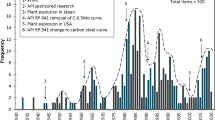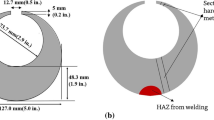Conclusion
Induction surface and bulk-surface hardening of steel in accordance with optimal regimes and the proper selection of the steels ensures the high in-service properties of various heavily loaded machine components.
As a result, the induction hardening of steel is being carried out at the leading establishments of the truck, tractor, and machine-building industry, and is the basic method for the thermal hardening of components in many cases.
The potential of induction heat treatment, however, is yet to be exhausted.
Studies devoted to further expansion of the sphere in which this method is used, to the transfer of leading experience, and to raising the level of technology at all establishments utilizing induction heat treatment are critical and urgent.
The further development, refinement, and implementation of induction heat treatment in machine building and metallurgy is a critical problem of scientific and technical progress in our country.
Similar content being viewed by others
Literature cited
V. P. Vologdin, Surface Hardening by the Induction Method [in Russian], Metallurgizdat, Moscow (1939).
V. P. Vologdin, Surface Induction Hardening [in Russian], Oboronizdat, Moscow (1947).
V. P. Vologdin, Machinery,48, 1234 (1936).
V. P. Vologdin, Electrician,116, 3026 (1936).
High-Frequency Currents in Industry [in Russian], Izd. Chelyabinskogo Obkoma VKP (b), Chelyabinsk (1944).
K. Z. Shepelyakovskii, "High-frequency currents operate for victory in the Urals," Metalloved. Term. Obrab. Met., No. 5, 12 (1985).
K. Z. Shepelyakovskii and S. E. Ryskin, Technique of Induction-Heating Usage [in Russian] Mashgiz, Moscow (1949).
"Conference on problems of high-frequency hardening," Radiofront, No. 11 (July), 12 (1941).
M. G. Lozinskii, Surface Hardening and Induction Heating of Steel [in Russian], Mashgiz, Moscow (1949).
G. I. Babat, Induction Heating of Metals and Its Industrial Application [in Russian], Gosénergoizdat, Leningrad (1950).
K. Z. Shepelyakovskii and M. O. Rabin, "Self-tempering during high-frequency surface hardening," Avtomob. Trakt. Prom., No. 8, 18 (1950).
K. Z. Shepelyakovskii, Self-Tempering of Steel during High-Frequency Hardening [in Russian], Mashgiz, Moscow (1955).
N. V. Geveling, Electrothermal Surface Treatment [in Russian], Otd. Naucho-Tekhnicheskoi Informatsii NKTP. Moscow-Leningrad (1936) p. 145.
V. D. Sadovskii, N. M. Rodigin, and M. A. Borodina, "Effect of structural heterogeneity on phase transformations during electric heating," Vestn. Mashinostr., No. 12, 12 (1948).
A. G. Spektor, "On the existence of the Geveling effect," Zh. Tekh. Fiz.,21, No. 10, 1153 (1951).
A. P. Gulyaev, "Problems of metal science and heat treatment as applies to high-frequencycurrent surface hardening," Industrial Application of High-Frequency Currents [in Russian], Mashgiz, Moscow-Leningrad (1952), p. 52.
I. N. Kidin, "Rational regimes for the high-frequency hardening of steel," Stal', No. 3, 240 (1953).
H. Osborn, The Tocco Process (1944), p. 45.
D. Martiu and H. Wiley, Trans. Am. Soc. Metallurg.,34, 131 (1945).
I. N. Kidin, Heat Treatment during Induction Hardening [in Russian], Metallurgizdat, Moscow (1950).
I. N. Kidin, Technological Features of the Heat Treatment of Steel Using Induction Heating [in Russian], Mashgiz, Moscow (1959), p. 63.
K. Z. Shepelyakovskii, V. D. Zelenova, and G. A. Ostrovskii, "The structure and properties of the hardened layer during induction hardening," Metalloved. Term. Obrab. Met., No. 9, 24 (1962).
K. Z. Shepelyakovskii, "Effect of induction hardening on the properties of steel," Metalloved. Term. Obrab. Met., No. 2, 15 (1962).
G. A. Ostrovskii, V. I. Sarrak, K. Z. Shepelyakovskii, and R. I. Éntin, "Effect of grain reduction on the properties of carbon steels after low tempering," Metalloved. Term. Obrab. Met., No. 6, 55 (1967).
P. M. Kelly and D. Natting, "Hardening mechanisms in steel," High-Strength Steel [Russian translation], Metallurgiya, Moscow (1965), p. 24.
K. Z. Shepelyakovskii, A. N. Marshalkin, and V. A. Kanygin, "Effect of the amount and dispersity of difficult-to-dissolve particles on the size of the austenite grain in steel with 0.6% C," Metalloved. Term. Obrab. Met., No. 8, 9 (1973).
K. Z. Shepelyakovskii, A. N. Marshalkin, and V. A. Kanygin, "Structural features and mechanical properties of carbon steel with niobium and vanadium," Metalloved. Term. Obrab. Met., No. 6, 68 (1974).
I. V. Kudryavtsev and V. N. Novikov, "Effect of surface hardening and carburizing on the fatigue strength and resilience of structural steels," Proceedings of the Central Scientific-Research Institute of Technology and Machine Building: Hardening of Machine-Building Grades of Steel by Surface Treatment [in Russian], Book 10, Mashgiz, Moscow (1947), p. 38.
I. V. Kudryavtsev, Internal Stresses as Strength Reserves in Machine Building [in Russian], Mashgiz, Moscow (1951).
É. V. Shleier and I. A. Oding, "Effect of surface hardening by high-frequency currents on the mechanical strength of structural grades of steel," Vestn. Metalloprom., No. 7, 7 (1940).
I. A. Oding, "Residual stresses and fatigue strength of steel hardened by high-frequency currents," Vestn. Mashinostr. Nos. 4-5, 23 (1943).
I. E. Kontorovich and L. S. Livshits, "Internal residual stresses induced in steel by high-frequency surface hardening," Metallurg, No. 8, 30 (1940).
Yu. M. Bogatyrev, G. A. Vashurova, and M. M. Klimochkin, "Residual stresses in steel surface-hardened at various heating temperatures," Proceedings of the Central Scientific-Research Institute of Technology and Machine Building: Induction Heating and the Strength Properties of Steel Subjected to Electrothermal Treatment [in Russian], Book 51, Mashgiz, Moscow (1953), p. 153.
I. N. Kidin, "Properties of steel hardened by high-frequency-current heating," Production-Technical Bulletin [in Russian], Nos. 6-7, Oborongiz, Moscow (1943), p. 27.
M. S. Kossoi, "Residual stresses and the cyclic strength of structural steel subjected to induction surface hardening," Proceedings of the Central Scientific-Research Institute of Technology and Machine Building: Induction Heating and Electrothermal Treatment [in Russian], Book 39, Mashgiz, Moscow (1950) p. 5.
K. Z. Shepelyakovskii and R. I. Éntin, "A new method for the surface hardening of mediummodulus pinions," Vestn. Mashinostr., No. 12, 53 (1958).
K. Z. Shepelyakovskii, "Investigations of surface hardened components formed from steels with reduced hardenability," Avtomob. Prom., No. 2, 33 (1960).
K. Z. Shepelyakovskii, "Surface hardening of rear-axle pinions formed from 55PP steel of reduced hardenability," Avtomob. Prom., No. 10, 39 (1962).
K. Z. Shepelyakovskii, "Steels for surface hardening," Metalloved. Term. Obrab. Met., No. 11, 24 (1959).
K. Z. Shepelyakovskii, "Structural steels of reduced hardenability," Metalloved. Term. Obrab. Met., No. 12, 8 (1960).
K. Z. Shepelyakovskii, "Steels with controlled hardenability for induction hardening," Metalloved. Term. Obrab. Met., No. 7, 18 (1980).
K. Z. Shepelyakovskii, Strengthening Machine Components by Surface Hardening with Induction Heating [in Russian], Mashinostroenie, Moscow (1972).
Inventor's Certificate No. 128545, "Apparatus for cooling cylindrical articles subjected to high-frequency surface hardening."
Yu. M. Bogatyrev, I. N. Shklyarov, and K. Z. Shepelyakovskii, "Effect of cooling rate on crack formation during the hardening of steel," Metalloved. Term. Obrab. Met., No. 4, 25 (1967).
E. I. Natanzon, Induction Heating in Truck Building [in Russian], Mashinostroenie, Moscow (1967).
K. Z. Shepelyakovskii, V. P. Devyatkin, B. K. Ushakov, et al., "Induction surface hardening of friction-bearing components," Metalloved. Term. Obrab. Met., No. 1, 17 (1974).
K. Z. Shepelyakovskii, N. M. Fonshtein, V. P. Devyatkin, et al., "Strength characteristics of high-carbon steel of controlled hardenability after bulk-surface hardening," Metalloved. Term. Obrab. Met., No. 5, 40 (1976).
I. N. Shklyarov and A. G. Orlovskii, "Automated equipment for heat treatment under induction heating," Metalloved. Term. Obrab. Met. No. 9, 24 (1977).
I. N. Shklyarov, "Deep-heat surface hardening of the divided axles of ZIL-130 trucks", Metalloved. Term. Obrab. Met., No. 7, 33 (1966).
V. A. Ognevskii, G. A. Ostrovskii, A. M. Ryskind, and I. N. Shklyarov, "Hardening of leaf springs using induction heating," Metalloved. Term. Obrab. Met., No. 7, 22 (1984).
I. N. Shklyarov, V. A. Ognevskii, G. A. Ostrovskii, and A. M. Ryskind, "Automated line for the fabrication of spring leaves with hardening by induction heating," Metalloved. Term. Obrab. Met., No. 7, 52 (1984).
G. V. Linetskii and R. E. Gliner, "Heat treatment of structural steel in truck building," Metalloved. Term. Obrab. Met. No. 12, 2 (1981).
E. I. Natanzon, V. F. Lysenko, and L. S. Temyanko, "Progressive electrothermal-treatment processes at the Gor'ky Truck Plant," Metalloved. Term. Obrab. Met., No. 12, 6 (1981).
K. Z. Shepelyakovskii, "On improving the efficiency of electrothermal treatment in machine building," Metalloved. Term. Obrab. Met., No. 8 56 (1978).
K. Z. Shepelyakovskii and B. K. Ushakov, "Induction bulk surface hardening as an effective method of conserving material resources," Metalloved. Term. Obrab. Met., No. 6, 51 (1984).
G. N. Sergeev, G. A. Khasin, V. G. Gikina, et al., Heat Treatment and Drawing of Steel Using High-Frequency Currents [in Russian], Metallurgiya, Moscow (1971).
I. N. Kidin, Physical Bases for the Electrothermal Treatment of Metals and Alloys [in Russian], Metallurgiya, Moscow (1969).
V. N. Gridnev, Yu. Ya. Neshkov, S. P. Omkadetov, and V. I. Trefilov, Physical Bases for the Electrothermal Hardening of Steel [in Russian], Naukova Dumka, Kiev (1973).
G. F. Golovin and M. M. Zamyatnin, High-Frequency Heat Treatment [in Russian] Mashigiz, Moscow-Leningrad (1959), p. 188; Mashinostroenie, Leningrad (1968).
G. F. Golovin, Residual Stresses and Deformations with Surface Hardening [in Russian], Mashinostroenie, Leningrad (1973).
Additional information
Moscow Institute of Advanced Metallurgy. Translated from Metallovedenie i Termicheskaya Obrabotka Metallov, No. 8, pp. 2–10, August, 1987.
Rights and permissions
About this article
Cite this article
Shepelyakovskii, K.Z. 50th Anniversary of induction surface hardening. Met Sci Heat Treat 29, 559–567 (1987). https://doi.org/10.1007/BF00763106
Issue Date:
DOI: https://doi.org/10.1007/BF00763106




